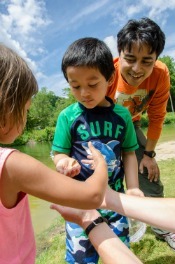Traveler - Beauty and the Bats!
Minnesota State Parks and Trails
Traveler
April 2017
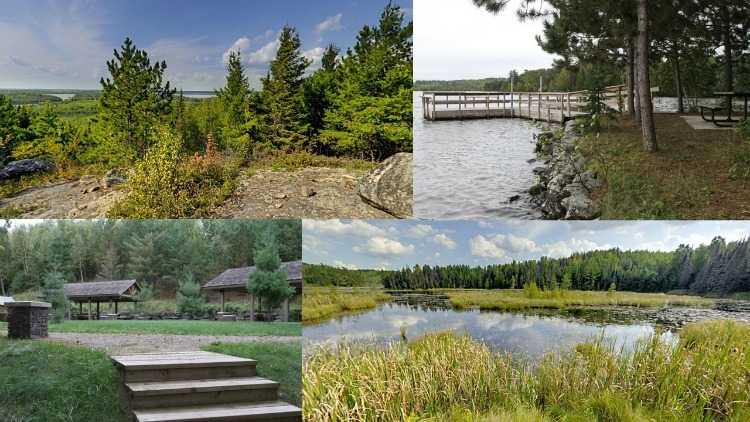
Lake Vermilion-Soudan Underground Mine State Park
Adventure abounds at beautiful Lake Vermilion-Soudan Underground Mine State Park! Take a boat out or cast a line on Lake Vermilion, or hike through acres of old growth pine forest. The addition of nearly 3,000 acres and five miles of Lake Vermilion shoreline in 2010 adds even more opportunities to experience the wonders of northern Minnesota. Watch for the park’s new campground, group camps and public water access to open mid-summer of 2017.
In this gorgeous park, you will also find Soudan Underground Mine, called the "Cadillac of Mines." Here visitors are issued hard hats for the half-mile underground tour, where guides share a fascinating history lesson on mining in Minnesota. Above ground, you can take in an evening bat program with a park naturalist to learn more about these magnificent night creatures who, beginning in April, will reappear in night skies throughout Minnesota. Learn which bats winter in the south and which ones hibernate. Discover how bats help people and find out what we can do to help our bats. To find dates and times for bat programs, check the online events calendar.
- Find maps, directions and other park information about Lake Vermilion-Soudan Underground Mine State Park.
- See the beautiful sights of the park with this snapshot tour.
- Mine tours resume Memorial Day Weekend and will run through mid-October, but you can reserve your tickets now.
The List - Underground Explorations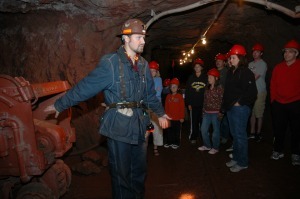
Geology rocks in Minnesota! From caves and mines to ancient potholes, there are a number of fascinating geologic sites to experience at Minnesota state parks. On the Minnesota Department of Natural Resources website you can find a short list of "cool" subterranean sites to visit.
Check out a YouTube video of Soudan Underground Mine.
Discover - Minnesota BatsMinnesota is home to seven species of bats. Like snakes, bats are poorly understood by most people. As a result, these tiny winged mammals are feared by many. But bats play important roles in the ecosystem, helping to keep insect populations in balance and, in turn, providing great economic benefits to farmers and others who depend on agricultural crops for their livelihood. Bat species found in Minnesota are very small, weighing from two-tenths of an ounce to slightly over one ounce. They feed mostly on flying insects, which they catch in their cupped tail membranes as they dart and weave through the nighttime air. Once an insect is caught, the bat transfers its prey to its mouth while in flight. Bats have a unique super-power called echo-location. They constantly emit supersonic cries. Their ears pick up echoes bouncing off objects. These echoes either guide bats toward prey or away from obstacles. |
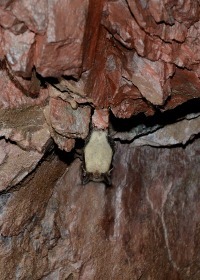 |
Get more information on the natural history of bats.
Game Time - Bat and Moth Game
To experience what it might be like for a bat to use echo-location, try this fun activity. You will need at least two players and a blindfold.
- Find a level area outside that is free from obstacles on the ground.
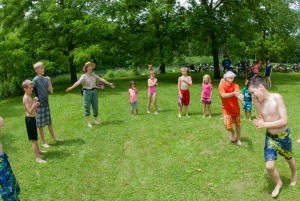
- If you have a large group, have everyone stand in a circle.
- Choose two players to go in the middle of the circle.
- One of the players will be blindfolded to represent the bat. The other person will represent the moth.
- Have the bat and moth stand facing each other.
- The bat claps once to represent the echolocation sound being emitted.
- The moth must clap twice to show the sound has bounced off the moth.
- The bat must track down the moth by walking around and trying to touch the moth.
- The moth must try and evade capture while remaining inside the circle.
Find more wildlife games you can try.
Traveler Tip - Preventing the Spread of WNS
White-nose Syndrome (WNS) is a disease that is killing hibernating bats in eastern North America. It is estimated that more than 5.7 million bats have died as a result of the disease.
Named for the white fungus that was observed on noses of the first infected bats, it also affects other body parts. A newly discovered fungus has been demonstrated to cause WNS in bats. The fungus thrives in cold, humid conditions characteristic of the caves and mines that bats use to hibernate.
WNS is transmitted bat to bat and does not affect humans. But there are a number of things you can do to help slow the spread of WNS and help our bats.
- After visiting a cave or mine, decontaminate clothing and gear according to recommended protocols.
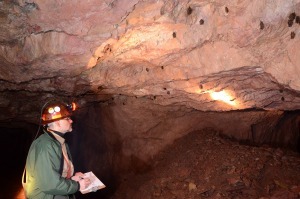
- Honor cave closures and gated caves and be familiar with cave advisories.
- Do not disturb hibernating bats.
- Report sick or dead bats and groups of bats.
- Enhance bat habitat on your property by retaining large trees, protecting wetlands, and constructing homes for bats.
- Use bat-friendly methods to exclude bats from your home. Never exclude bats when females are raising young (May - August).
- Become a citizen scientist by helping out during a state park Summer Bat Count. Check the online events calendar to find program locations.
![]()
Find out the latest on White-nose Syndrome in Minnesota.
April Events - Wildlife Programs at Parks
|
Find more naturalist programs.
Keep reading! For past issues of the Traveler, click here.



